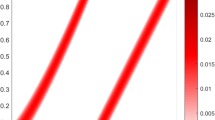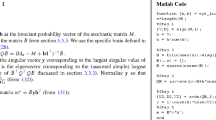Abstract
We study a notion of knockout robustness of a stochastic map (Markov kernel) that describes a system of several input random variables and one output random variable. Robustness requires that the behaviour of the system does not change if one or several of the input variables are knocked out. Gibbs potentials are used to give a mechanistic description of the behaviour of the system after knockouts. Robustness imposes structural constraints on these potentials. We show that robust systems can be described in terms of suitable interaction families of Gibbs potentials, which allows us to address the problem of systems design. Robustness is also characterized by conditional independence constraints on the joint distribution of input and output. The set of all probability distributions corresponding to robust systems can be decomposed into a finite union of components, and we find parametrizations of the components.





Similar content being viewed by others
References
Albert I, Thakar J, Li S, Zhang R, Albert R (2008) Boolean network simulations for life scientists. Source Code Biol Med 3:16
Ay N, Krakauer DC (2007) Geometric robustness theory and biological networks. Theory Biosci 125(2):93–121
Birolini A (2010) Reliability engineering: theory and practice. 6th edn. Springer, Berlin
Boldhaus G, Bertschinger N, Rauh J, Olbrich E, Klemm K (2010) Robustness of Boolean dynamics under knockouts. Phys Rev E 82(2):021916
Drton M, Sturmfels B, Sullivant S (2009) Lectures on algebraic statistics. 1st ed., ser. Oberwolfach Seminars. Birkhäuser, Basel, vol. 39.
Fink A (2011) The binomial ideal of the intersection axiom for conditional probabilities. J Algeb Comb 33(3):455–463
Herzog J, Hibi T, Hreinsdóttir F, Kahle T, Rauh J (2010) Binomial edge ideals and conditional independence statements. Adv Appl Math 45(3):317–333
Jarrah A.S, Raposa B, Laubenbacher R (2007) Nested canalyzing, unate cascade, and polynomial functions. Physica D 233(2):167–174
Kauffman S (1993) The origins of order: self-organization and selection in evolution. Oxford University Press, Oxford
Kauffman S, Peterson C, Samuelsson B, Troein C (2003) Random Boolean network models and the yeast transcriptional network. PNAS 100(25):14796–14799
Kauffman S, Peterson C, Samuelsson B, Troein C (2004) Genetic networks with canalyzing Boolean rules are always stable. PNAS 101(49):17102–17107
Lauritzen SL (1996) Graphical Models. In: Oxford Statistical Science Series, 1st edn. Oxford University Press, Oxford
Moreira AA, Amaral LN (2005) Canalizing Kauffman networks: nonergodicity and its effect on their critical behavior. Phys Rev Lett 94:218702
Ohtani M (2011) Graphs and ideals generated by some 2-minors. Commun Algebra 39(3):905–917
Rauh J (2013) Generalized binomial edge ideals. Adv Appl Math 50(3):409–414
Schuster P, Fontana W, Stadler PF, Hofacker IL (1994) From sequences to shapes and back: a case study in RNA secondary structures. Proc Roy Soc Lond B 255:279–284
Swanson I, Taylor A (2011) Minimal primes of ideals arising from conditional independence statements. J Algebra. Preprint: arXiv:1107.5604v3
de Visser JAGM, Hermisson J, Wagner GP, Meyers LA, Bagheri-Chaichian H, Blanchard JL, Chao L, Cheverud JM, Elena SF, Fontana W, Gibson G, Hansen TF, Krakauer D, Lewontin RC, Ofria C, Rice SH, von Dassow G, Wagner A, Whitlock MC (2003) Perspective: evolution and detection of genetic robustness. Evolution 57(9):1959–1972
Wagner G, Stadler PF (2003) Quasi-independence, homology and the unity of type: a topological theory of characters. J Theor Biol 220:505–527
Acknowledgments
This work has been supported by the Volkswagen Foundation and the Santa Fe Institute. Nihat Ay thanks David Krakauer and Jessica Flack for many stimulating discussions on robustness. We thank the reviewers for their detailed remarks which helped us to improve our manuscript.
Author information
Authors and Affiliations
Corresponding author
Rights and permissions
About this article
Cite this article
Rauh, J., Ay, N. Robustness, canalyzing functions and systems design. Theory Biosci. 133, 63–78 (2014). https://doi.org/10.1007/s12064-013-0186-3
Received:
Accepted:
Published:
Issue Date:
DOI: https://doi.org/10.1007/s12064-013-0186-3




